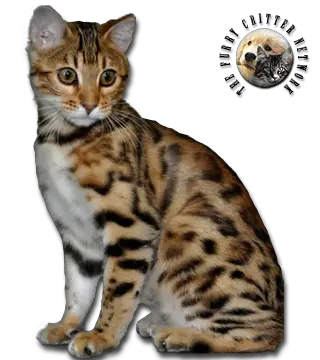Breed Standard
Head: Rather large with rounded contours. Slightly longer than wide. Gently curves from forehead to bridge. High, prominent cheekbones. Full, broad muzzle. Large, broad nose with very slight concave curve. Pronounced jaws.
Eyes: Large, oval, set wide apart, slanting slightly up toward the base of the ear. All colors permissible except blue and aquamarine. Blue in Seal Lynx Point Blues; yellow to green in Brown Tabbies; Blue-green in Seal Mink Tabbies.
Neck: Long, thick, muscular, and powerful. Length in proportion to body.
Body: Long, large, and powerful, but not oriental. Robust bone structure and powerful musculature.
Paw: Medium in length, slightly longer in the back than in front. Strong, substantial bone structure. Large, round paws. Black pads.
Tail: Medium in length, thick, tapering to a rounded tip.
Coat: Short and fine. Thick, luxurious, and unusually soft to the touch. Colors and patterns include: - Spotted Tabby, with spots being black, chocolate, or cinnamon in color. Orange ground color is preferred. Black horizontal shoulder streaks and rings on the tail, with the tip being black. - Marbled Tabby, with broad oyster shell pattern on the flanks and butterfly markings at the shoulders. The coat of the "Snow Leopard" is white with spots and marbling ranging from red to black; blue eyes.
Fault: Spots on body running together and forming stripes. Absence of black on tip of tail. Belly not spotted. Pink pads, or pads not all of the same color.
History
A golden, black-spotted coat like that of the Asian Leopard Cat, the Bengal Cat's wild ancestor. In 1963, Jean Mill, a Californian breeder, purchased a wild cat, the Asian Leopard, Felis prionailurus bengalensis, a miniature leopard with a spotted coat that is a strong swimmer and excellent fisher. She crossed the cat with an American Shorthair queen, creating a breed of domestic cats presenting the physical features of wild cats. The females resulting from this cross were fertile. When crossed with the sire, they gave birth to kittens with spotted coats. Thus was the Bengal breed created. In 1973, Dr. Centerwall of the University of California continued this crossbreeding program to determine the Asian Leopard Cat's resistance to feline leukemia. He gave eight of these hybrids to Jean Mill, who continued her selective breeding program. Siamese, Egyptian Mau, and Burmese cats were used by breeders to create new lines. The first specimen, "Millwood Finally Found" was registered with T.I.C.A. in 1983. The F.I.Fe only recently recognized the Bengal; the C.F.A. does not recognize the breed. The Bengal cat was introduced in France in 1991. This breed is part of the new generation of "wild cats" and is still quite rare.
Behavior
This even-tempered cat makes a pleasant companion provided he is of the fourth to seventh generation following crossing of a domestic with an Asian Leopard. Nevertheless, the Bengal's hunter instinct and energy are beyond that of most cats. Kittens tend to be destructive. The male is reputed to be more friendly than the female Bengal, who is often very independent and temperamental, strongly expressing her anger and very effusive in her displays of affection. The Bengal gets along with other cats and dogs, but this breed's "wild" behaviors sometimes appear. The lively, active Bengal Cat loves exercise and the water. Rather exclusive with his owner, who must devote time to him, this cat can be as affectionate as any other. The Bengal has a quiet voice. Care is easy.
Health
Since the late 1960s—when the Bengal cat was developed through hybridization of Asian Leopard cats and domestic cats, it has gained huge popularity. However, in recent years, a novel early-onset autosomal recessive disorder was described in this breed. This disease appears to be an early-onset primary photoreceptor disorder, leading to blindness within the first year of age.






